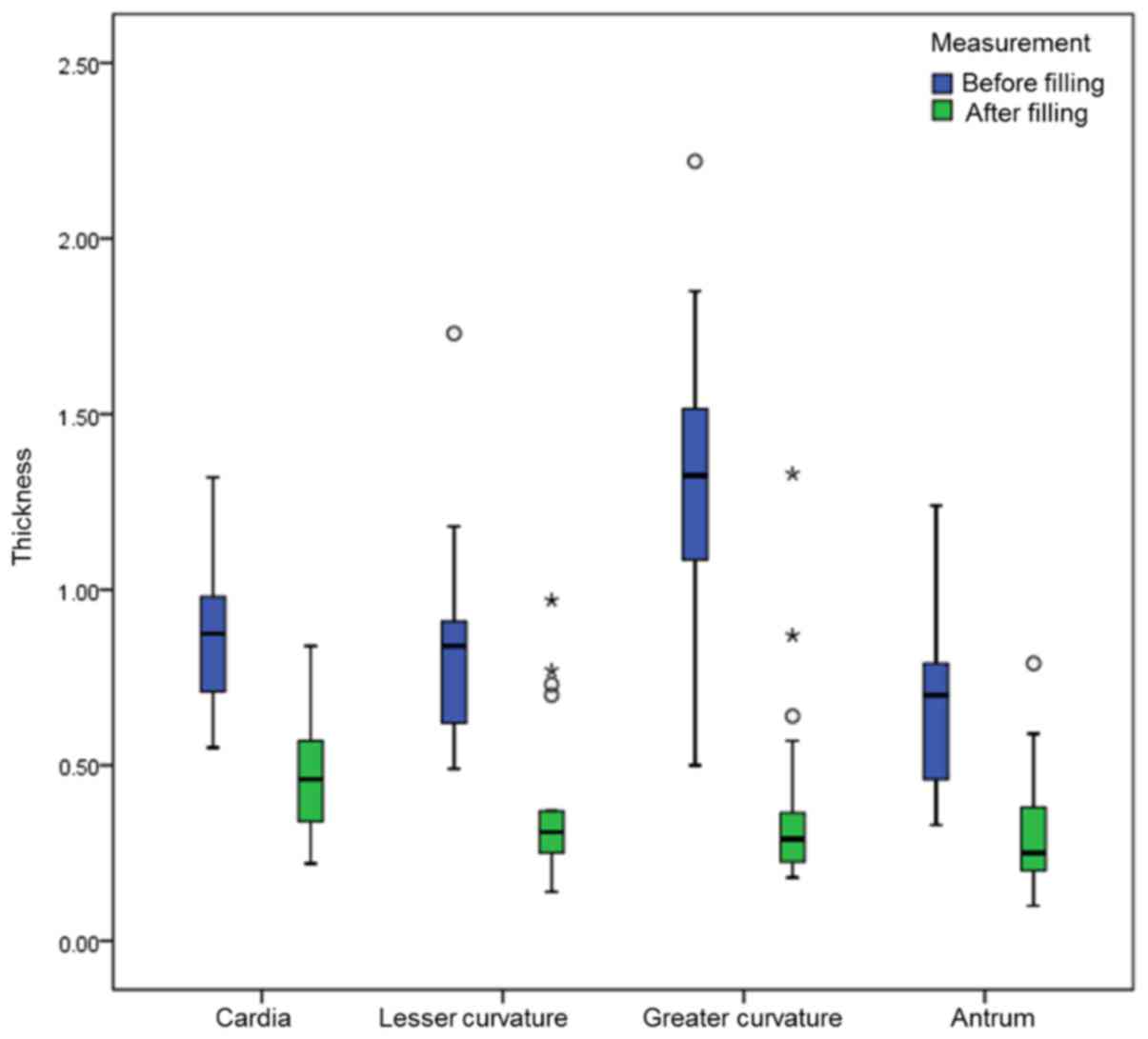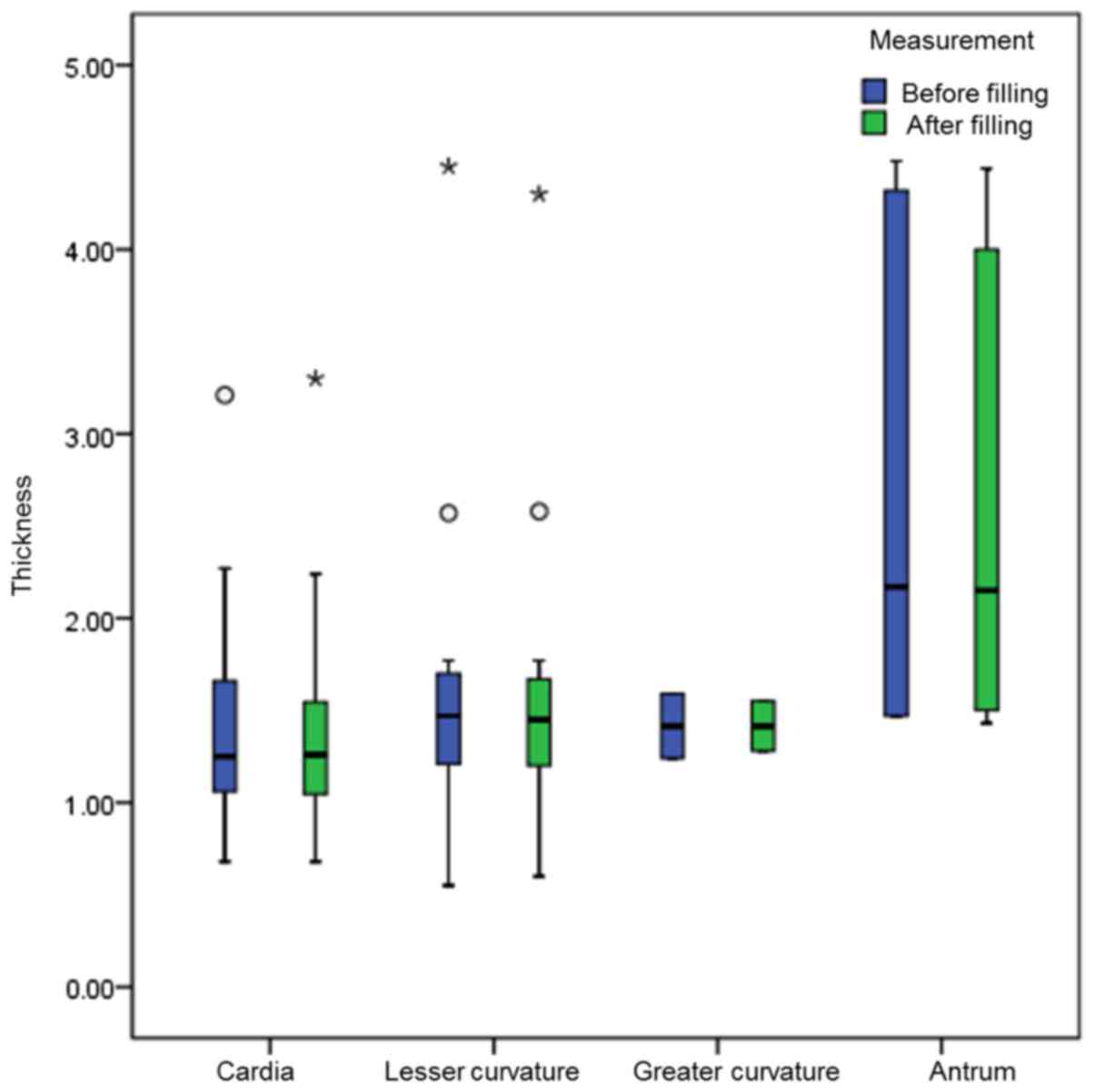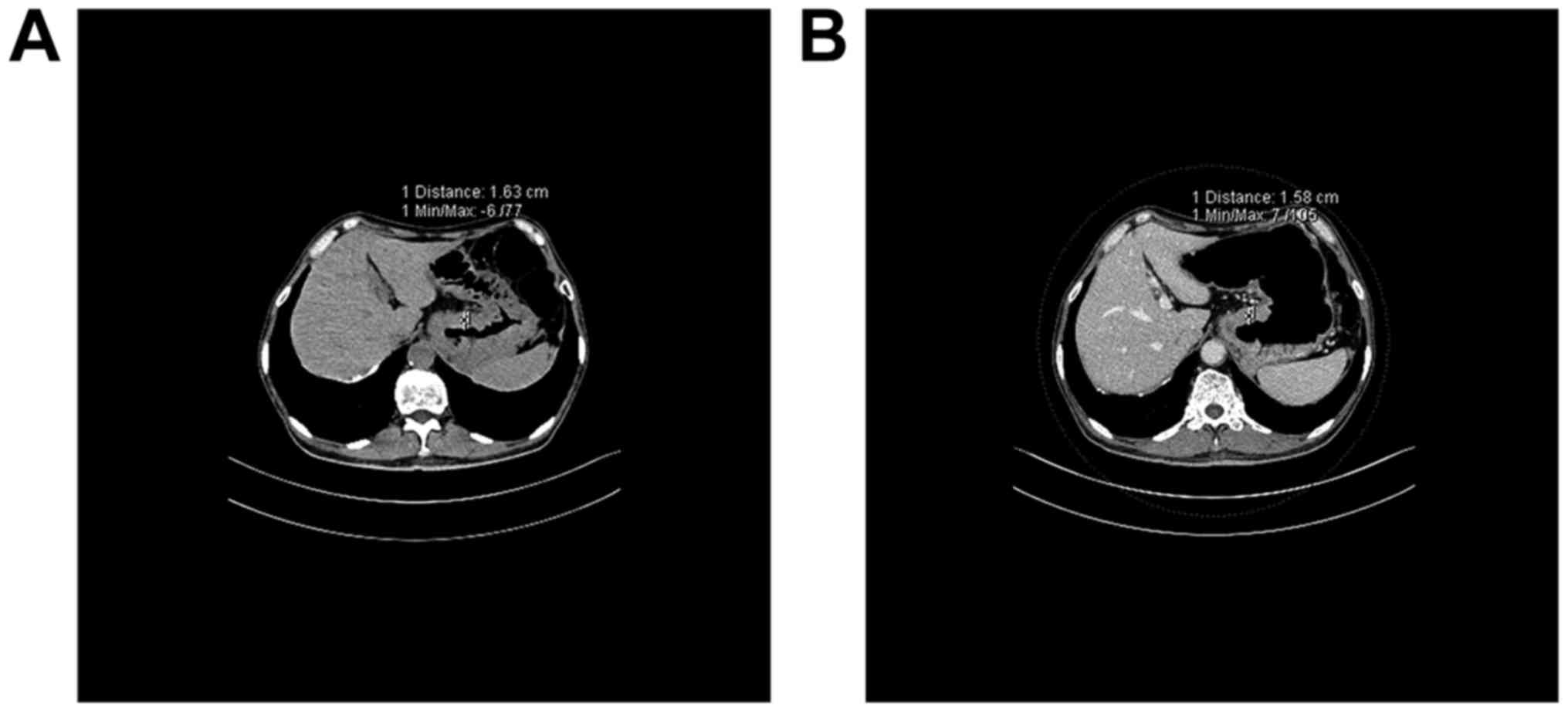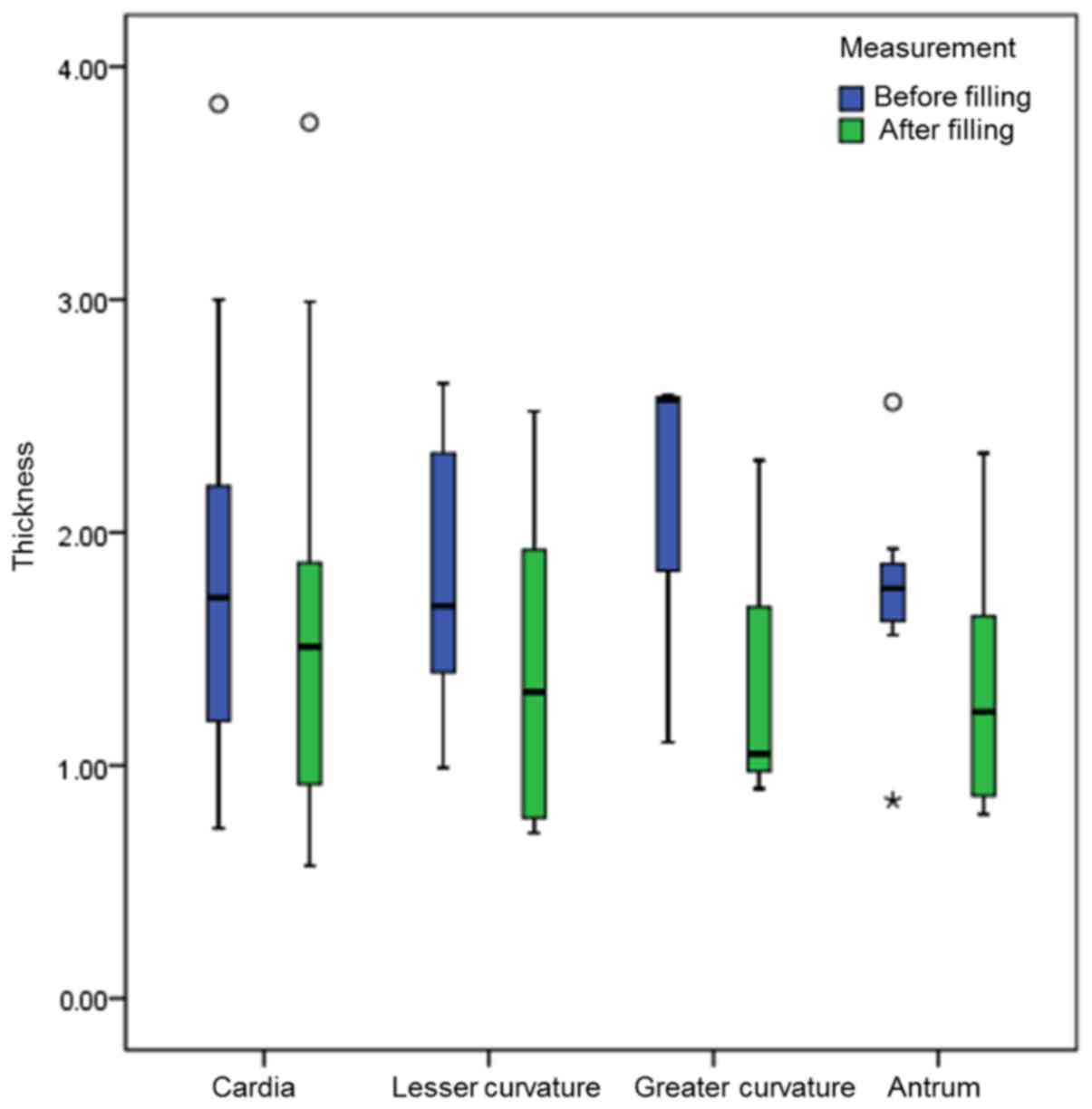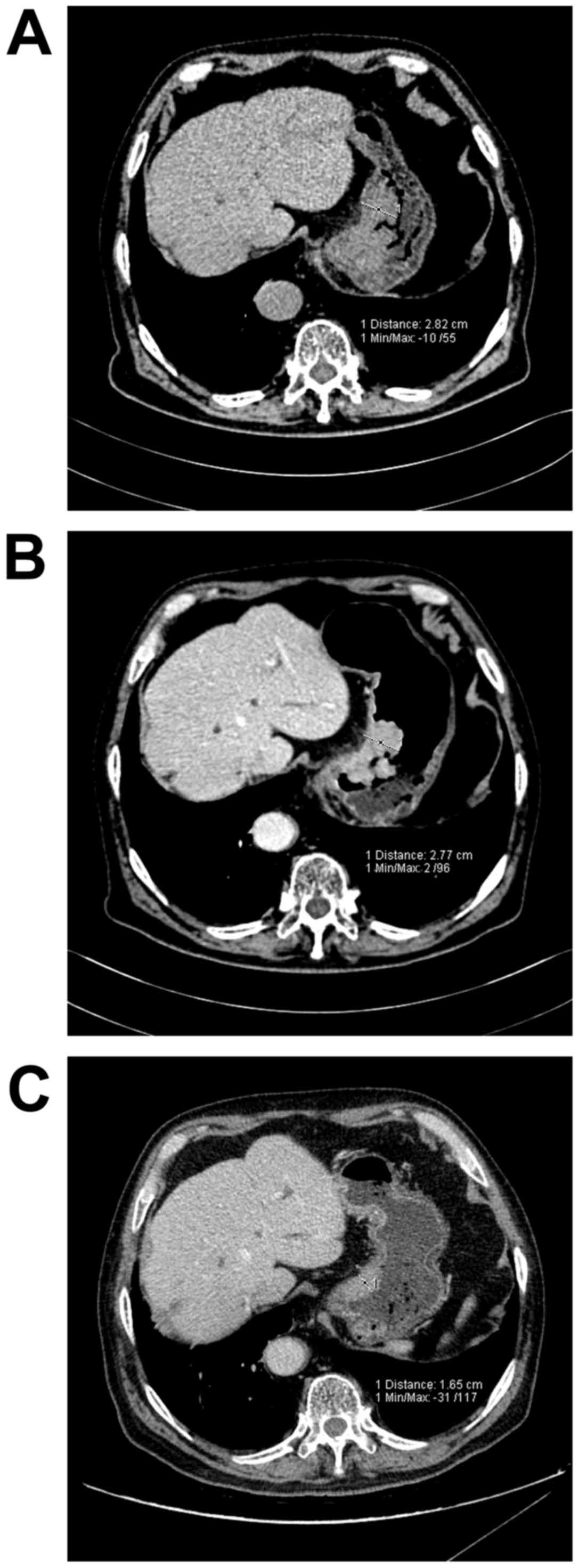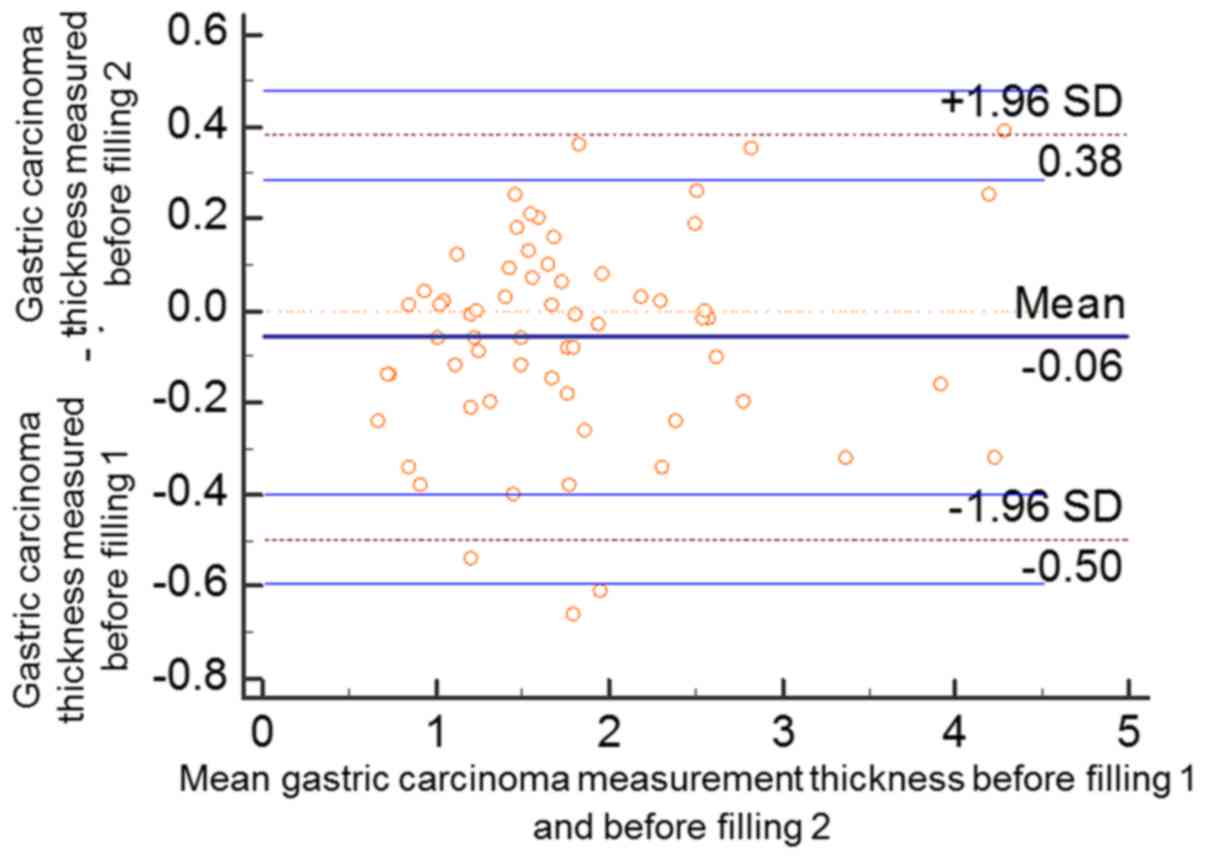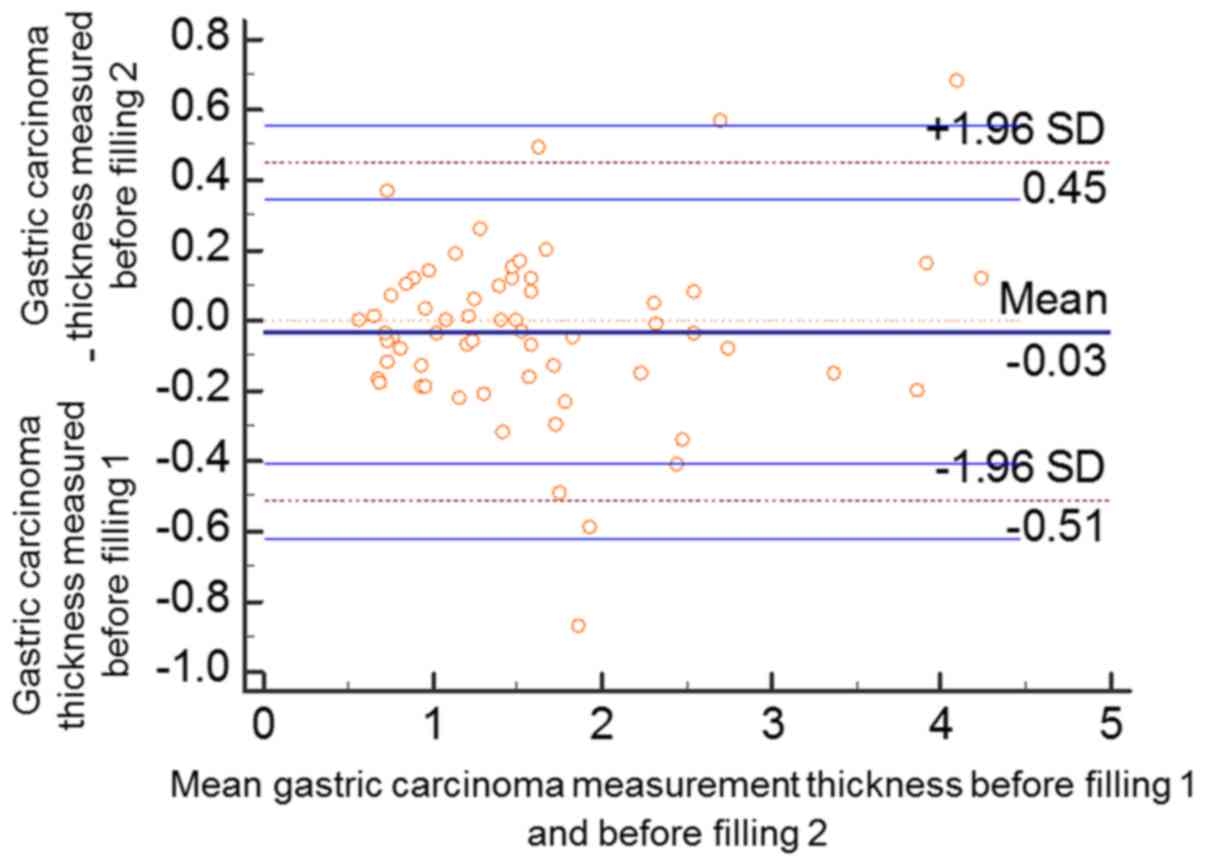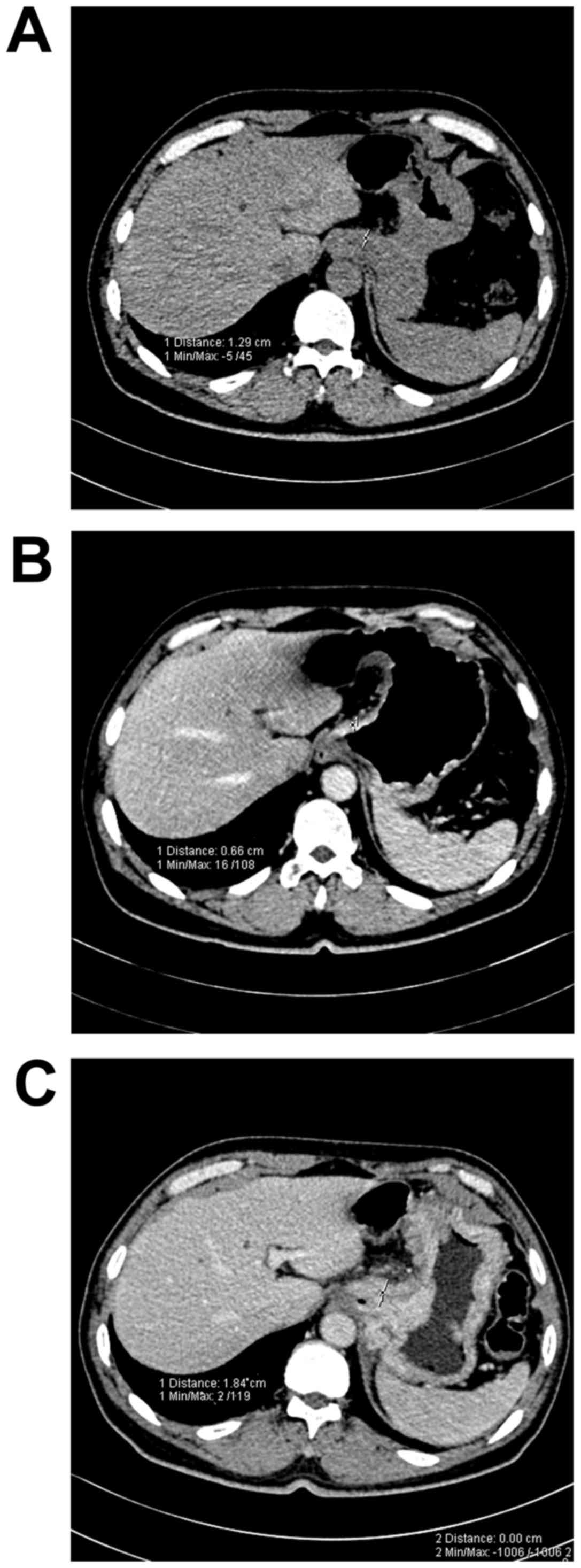|
1
|
Hallinan JT and Venkatesh SK: Gastric
carcinoma: Imaging diagnosis, staging and assessment of treatment
response. Cancer Imaging. 13:212–227. 2013. View Article : Google Scholar : PubMed/NCBI
|
|
2
|
Carl-Mcgrath S, Ebert M and Röcken C:
Gastric adenocarcinoma: Epidemiology, pathology and pathogenesis.
Cancer Therapy. 6:877–893. 2008.
|
|
3
|
Zuo T, Zheng R, Zeng H, Zhang S and Chen
W: Epidemiology of stomach cancer in China. Chin J Clin Oncol.
44:52–58. 2017.
|
|
4
|
Ghiţă D, Glavici A, Pleşea IE, Săftoiu A,
Dumitrescu D and Ciurea T: Invasion assessment in gastric
carcinoma-imagistic and histopathologic combined study. Rom J
Morphol Embryol. 52(Suppl 1): S349–S361. 2011.
|
|
5
|
Moschetta M, Stabile Ianora AA, Anglani A,
Marzullo A, Scardapane A and Angelelli G: Preoperative T staging of
gastric carcinoma obtained by MDCT vessel probe reconstructions and
correlations with histological findings. Eur Radiol. 20:138–145.
2010. View Article : Google Scholar : PubMed/NCBI
|
|
6
|
Kim JH, Eun HW, Hong SS, Kim YJ, Han JK
and Choi BI: Gastric cancer detection using MDCT compared with 2D
axial CT: Diagnostic accuracy of three different reconstruction
techniques. Abdom Imaging. 37:541–548. 2012. View Article : Google Scholar : PubMed/NCBI
|
|
7
|
Bhandari S, Shim CS, Kim JH, Jung IS, Cho
JY, Lee JS, Lee MS and Kim BS: Usefulness of three-dimensional,
multidetector row CT (virtual gastroscopy and multiplanar
reconstruction) in the evaluation of gastric cancer: A comparison
with conventional endoscopy, EUS, and histopathology. Gastrointest
Endosc. 59:619–626. 2004. View Article : Google Scholar : PubMed/NCBI
|
|
8
|
Furukawa K, Miyahara R, Itoh A, Ohmiya N,
Hirooka Y, Mori K and Goto H: Diagnosis of the invasion depth of
gastric cancer using MDCT with virtual gastroscopy: Comparison with
staging with endoscopic ultrasound. AJR Am J Roentgenol.
197:867–875. 2011. View Article : Google Scholar : PubMed/NCBI
|
|
9
|
Washington K: 7th Edition of the AJCC
Cancer Staging Manual: Stomach. Ann Surg Oncol. 17:3077–3079. 2010.
View Article : Google Scholar : PubMed/NCBI
|
|
10
|
DI Cicilia R, Mordenti P, Anselmi E,
Paties C, Carella E and Cavanna L: HER2-positive gastric cancer
showing marked thickening of the gastric wall on ultrasonographic
and computed tomographic scans. A chance phenomenon or a specific
behaviour of this cancer type? Report of three cases. Anticancer
Res. 34:5083–5086. 2014.PubMed/NCBI
|
|
11
|
Lee SM, Kim SH, Lee JM, Im SA, Bang YJ,
Kim WH, Kim MA, Yang HK, Lee HJ, Kang WJ, et al: Usefulness of CT
volumetry for primary gastric lesions in predicting pathologic
response to neoadjuvant chemotherapy in advanced gastric cancer.
Abdom Imaging. 34:430–440. 2009. View Article : Google Scholar : PubMed/NCBI
|
|
12
|
Beer AJ, Wieder HA, Lordick F, Ott K,
Fischer M, Becker K, Stollfuss J and Rummeny EJ: Adenocarcinomas of
esophagogastric junction: Multi-detector row CT to evaluate early
response to neoadjuvant chemotherapy. Radiology. 239:472–480. 2006.
View Article : Google Scholar : PubMed/NCBI
|
|
13
|
Wieder HA, Beer AJ, Lordick F, Ott K,
Fischer M, Rummeny EJ, Ziegler S, Siewer JR, Schwaiger M and Weber
WA: Comparison of changes in tumor metabolic activity and tumor
size during chemotherapy of adenocarcinomas of the esophagogastric
junction. J Nucl Med. 46:2029–2034. 2005.PubMed/NCBI
|
|
14
|
Horton KM and Fishman EK: Current role of
CT in imaging of the stomach. Radiographics. 23:75–87. 2003.
View Article : Google Scholar : PubMed/NCBI
|
|
15
|
Gligorievski A: CT evaluation of gastric
lymphoma. Prilozi. 30:125–138. 2009.PubMed/NCBI
|
|
16
|
Giuliani A, Caporale A, Di Bari M, Demoro
M, Gozzo P, Corona M, Miccini M, Ricciardulli T and Tocchi A:
Maximum gastric cancer diameter as a prognostic indicator:
Univariate and multivariate analysis. J Exp Clin Cancer Res.
22:531–538. 2003.PubMed/NCBI
|
|
17
|
Ahn HS, Kim SH, Kodera Y and Yang HK:
Gastric cancer staging with radiologic imaging modalities and UICC
staging system. Dig Surg. 30:142–149. 2013. View Article : Google Scholar : PubMed/NCBI
|
|
18
|
Kim JW, Shin SS, Heo SH, Choi YD, Lim HS,
Park YK, Park CH, Jeong YY and Kang HK: Diagnostic performance of
64-section CT using CT gastrography in preoperative T staging of
gastric cancer according to 7th edition of AJCC cancer staging
manual. Eur Radiol. 22:654–662. 2012. View Article : Google Scholar : PubMed/NCBI
|
|
19
|
Kajitani T: The general rules for gastric
cancer study in surgery and pathology. Part I. Clinical
classification. Jpn J Surg. 11:127–139. 1981.
|
|
20
|
Miederer SE and Schepp W: The mucosal
barrier of the stomach. Anatomic structure and function. Dtsch Med
Wochenschr. 110:852–856. 1985.(In German). View Article : Google Scholar
|
|
21
|
Lim JH and Jeong YM: Sonography of the
stomach: An in vitro study to determine the anatomic cause of inner
hyperechoic and hypoechoic layers of the gastric wall. AJR Am J
Roentgenol. 162:335–338. 1994. View Article : Google Scholar : PubMed/NCBI
|
|
22
|
Kim HJ, Kim AY, Oh ST, Kim JS, Kim KW, Kim
PN, Lee MG and Ha HK: Gastric cancer staging at multi-detector row
CT gastrography: Comparison of transverse and volumetric CT
scanning. Radiology. 236:879–885. 2005. View Article : Google Scholar : PubMed/NCBI
|
|
23
|
Fukuya T, Honda H, Kaneko K, Kuroiwa T,
Yoshimitsu K, Irie H, Maehara Y and Masuda K: Efficacy of helical
CT in T-staging of gastric cancer. J Comput Assist Tomogr.
21:73–81. 1997. View Article : Google Scholar : PubMed/NCBI
|
|
24
|
Tang L, Li ZY, Li ZW, Zhang XP, Li YL, Li
XT, Wang ZL, Ji JF and Sun YS: Evaluating the response of gastric
carcinomas to neoadjuvant chemotherapy using iodine concentration
on spectral CT: A comparison with pathological regression. Clin
Radiol. 70:1198–1204. 2015. View Article : Google Scholar : PubMed/NCBI
|
|
25
|
Kumano S, Okada M, Shimono T, Kuwabara M,
Yagyu Y, Imaoka I, Ashikaga R, Ishii K and Murakami T: T-staging of
gastric cancer of air-filling multidetector-row CT: Comparison with
hydro-multidetector-row CT. Eur J Radiol. 81:2953–2960. 2012.
View Article : Google Scholar : PubMed/NCBI
|
|
26
|
Moschetta M, Scardapane A, Telegrafo M,
Lorusso V, Angelelli G and Stabile Ianora AA: Differential
diagnosis between benign and malignant ulcers: 320-row CT virtual
gastroscopy. Abdom Imaging. 37:1066–1073. 2012. View Article : Google Scholar : PubMed/NCBI
|
|
27
|
Yen PP and Stevenson G: Two- and
three-dimensional examination of the stomach (virtual gastroscopy):
Technical note. Can Assoc Radiol J. 61:41–43. 2010. View Article : Google Scholar : PubMed/NCBI
|
|
28
|
Okten RS, Kacar S, Kucukay F, Sasmaz N and
Cumhur T: Gastric subepithelial masses: Evaluation of multidetector
CT (multiplanar reconstruction and virtual gastroscopy) versus
endoscopic ultrasonography. Abdom Imaging. 37:519–530. 2012.
View Article : Google Scholar : PubMed/NCBI
|
|
29
|
Takahashi S, Hirayama M, Kuroiwa G, Kawano
Y, Takada K, Sato T, Miyanishi K, Sato Y, Takimoto R, Kobune M and
Kato J: Diagnostic validity of CT gastrography versus gastroscopy
for primary lesions in gastric cancer: Evaluating the response to
chemotherapy, a retrospective analysis. Gastric Cancer. 16:543–548.
2013. View Article : Google Scholar : PubMed/NCBI
|



